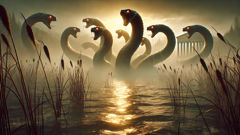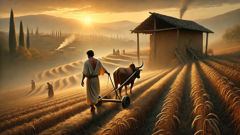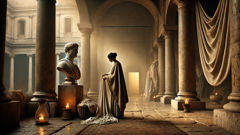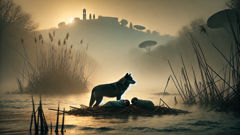Introduction
The marsh of Lerna lay like a wound across the hills, a place where sky and swamp met in a shifting, breathless gray. Fish moved in blind schools beneath the reed crowns, and frogs made a steady percussion beneath a low, humid air. Villagers kept their distance; even the dogs at the edge of the fields refused the mud. Old women spoke in low voices of a scent that rose from the marsh in certain seasons—sour as iron, sweet as rot—a scent that carried with it the sound of something long and patient slithering through the shallows. They said the water did not like to be looked at directly, that it clung to the edges of sight like a secret memory.
Into that place the word of monster and guardian braided together. Some called it a guardian because the springs fed a small, stubborn grove that seemed greener than the rest of the valley; others called it a monster because shepherds lost flocks without tracks in the mud, and because a child who wandered too close once returned with hair stiff as reeds and silence in his eyes. The earliest songs that touched on the creature were halting; the story hardened into form later when travelers returned from the high road to tell of a beast with many heads and a venomous breath. Lerna's name became a shorthand for danger, and with danger come the rites, the sacrifices, and the tales told to keep shoulders squared against what cannot be tamed.
The Lernaean Hydra, in the telling that later men would pass down as part of Heracles' labors, was a creature of wet darkness and cold cleverness. Its body was larger than a bull's, length coiled like an old rope, scales that caught the half light of dawn and held it like a promise. Each head was quick to taste the air, tasting what the others had not yet decided, and the mouths dripped with a venom that smelled like ruined copper. What made the Hydra more than a mere giant snake was the rumor that when a head was cut away, two more took its place in the same wound—an affront to the simple arithmetic of death that men trusted. Those who fought it first learned the rules the hard way: brute force bred multiplication, violence invited escalation. To face the Hydra required a mind comfortable with paradox: the stronger you struck, the worse the problem grew.
This is the beginning of the tale that holds both the damp, earthy world of Lerna and the bright, determined course of a man named Heracles. He would come not simply with strength but with the readiness to bend the fight until it met his reason; he would be aided by a friend who understood how fire could outrun regrowth. The story is not only one of bodies and bites; it is a story about how communities survive what the landscape will not yield. In the long nights by hearths and at temple altars, men and women traced this legend into patterns—lessons about cunning and cooperation, about sacrifice and the price of triumph. Lerna, the swamp, and the many-headed shadow that called it home remained, in the spoken memory, a challenge and a mirror: the Hydra could be slain, the marsh could be crossed, but the marks of the clash—charred reed, poisoned water, a god-printed scar—would remain to remind everyone who paid attention that victory is often a reshaping rather than a vanishing.
Origins and Omen: Lerna, Landscape, and the First Whispers
The terrain around Lerna is not merely an environmental detail in the story of the Hydra; it is the first actor. Travelers arriving from the sun-drenched, open plains found themselves lowered into a different world: a cool, damp amphitheater where fog pooled like thought and the sound came muffled, as if filtered through wool. The marsh swallowed footsteps and made the simplest paths labyrinthine. Within this world the inhabitants developed a language of borders—stakes to mark firm ground, ropes to guide harvesters through reeds, small shrines of driftwood and beaten bronze to protest to the gods on behalf of the lost. The landscape shaped their rites, and the rites shaped the story of the monster that protected and punished the water.

The earliest record of the Hydra is not in a painted vase or an official inscription but in the practical complaints of farmers. They spoke of wells that would not hold, of fish turning up bloated with a blackness under a scale, and of a spring near an old stone which seethed when the moon was full. Children came back from play with fixations in their eyes; men found their nets shredded by teeth that were not of familiar beasts. Where Europeans centuries later might have cataloged species, early Lernaens simply attributed these phenomena to intentional agency. The water was alive with a single will—capricious, jealous, ancient.
Myth grows fastest where explanation stalls. Priests in laconically tiled sanctuaries constructed stories that made sense of the marsh. If a god had a temple nearby it was because the god had influence over the spring, and if their rites were ignored, the deity might send some creature to press the matter. The Hydra, as the tale hardened, was both embodiment and instrument. Some elders insisted the creature had been born of Typhon and Echidna, those monstrous parents whose bloodlines threaded many Greek terrors, while some whispered that the earth itself had birthed it as punishment for an offended Naiad. The explanations shift with the teller, but the core—an enormous serpentine being that defended a certain portion of the landscape and punished trespassers—remained consistent.
Before the arrival of Heracles, the village devised expedients that looked like a combination of superstition and practical response. Men built small bonfires near the edges of rich water to slow the damp's encroachment; they maintained low-level offerings each month, visible tokens to remind whatever watched that humans had not forgotten it. Young hunters trained in cautious stillness, because the Hydra's heads were known to peer from different directions, almost as if conscious of their collective blind spots. A single hunter might glimpse one head gliding along a reed and tell himself it was the size of a calf; the next man would swear he had seen three heads at once with tongues like coals. The differing accounts knit together into the impression of a being that was both many and one.
Violence without thought taught the villagers an important rule about the Hydra: wounds complicated it. When a thrown spear took off a head, the blood boiled and the hole where the head had been knit into a new pair the following dawn. The old arithmetic of death—one wound, one cessation—failed. There are few things in human life so unnerving as the discovery that a practiced method of order suddenly no longer holds. The narrative needed a counterintuitive answer: what if the way to conquer something that multiplied under force was not to apply more force but to change the rules of engagement?
The people of Lerna lived with that question, and their rituals hardened into a kind of instruction manual for the future warrior who might come. They taught that some things required a partner, someone who could tend the aftermath while another child of the land did what had to be done. They taught that fire mattered—that heat could cauterize and deny the anger of the swamp a place to regrow. These were not mere folk superstitions; they were experiential knowledge, born from observation of the creature's behavior. It is a point often smoothed over in short retellings of the Hydra: the community had a role in its defeat. Stories of isolated heroism are cleaner, but the truth braided into the longer versions is more complex—an ecology of people, place, and beast.
Religious actors also contributed to the Hydra's legend by reading omens in the weather and the animal world. Birds refused to pass over certain reeds; ants built paths away from particular stones. A local oracle might declare that the Hydra's presence kept the grove alive for a time, a grim bargain between fertility and peril. Temples nearby made offerings on behalf of far-off farmers, and the price of those offerings often revolved around the maintenance of boundaries: keep your altars tended, and perhaps the Hydra will take the sheep of strangers instead of yours. The narrative, as it accreted, became a negotiation between the practical needs of people who lived at the marsh's edge and the symbolic demands of a creature who seemed to demand not only meat but proper attention.
The arrival of Heracles in this scene was therefore not merely a deus ex machina but a culmination of local expectation. Labors given by a king or demanded by a god often contained echoes of public anxieties. When Heracles was tasked with the Hydra, he entered a theater that had been rehearsing for centuries. The hero arrived with the reputation of a man too large for ordinary contests: his labors had already begun to reconfigure the landscape of myth. Yet Lerna required a recalibration. Strength alone could not account for the paradox the villagers had lived with; intelligence and partnership would have to accompany might. The stage was set not just for a struggle between a man and a monster, but for a weaving together of local knowledge, strategy, and the more personal stakes of name and reputation.
By the time the traveler leaves this part of the telling, it should be clear that the Hydra is a story about a place as much as it is about a thing. The marsh needs to be seen, tasted, and understood; its wetness is the first sentence of the myth. The Hydra's multiplicity—those heads that multiply in response to violence—raises the stakes and asks the listener to think about consequences. In a landscape where the simplest action might produce a multiplied harm, the community's memory keeps a ledger. That ledger is what will guide the hero who arrives next: this place remembers, and those who come after inherit that memory.
The Battle and the Craft: Heracles, Iolaus, and the End of the Hydra
This is the part of the tale that many remember most vividly: the clash in the reeds, the hiss and the spray, and the anomaly of heads sprouting where only wounds had been left. But to reduce the episode to a spectacle is to lose the layered strategy that made the victory possible. Heracles did not stride into Lerna like a man who expected sheer force to deliver a permanent result. He came with experience: previous labors had taught him both to test what he could bend and to listen to the knowledge of others. He also came with Iolaus, a companion who would play a decisive role—someone accustomed to the practicalities of tending fire, watching wounds, and acting quickly. The duel, then, is not only between man and beast but between two modes of action: the immediate, visible strike and the patient, sustaining care that follows.
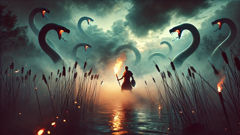
When Heracles first crossed into the swamp, his figure was like a blunt instrument of light among the living gray. His bronze sword and club shone bitter against the low sun, and the air smelled sharp where his cloak had brushed reeds. The Hydra watched; the multiple heads craned, tasting the air with flicked tongues. It moved with a patience that betrayed a different kind of confidence: a predator certain of the rules. Heracles struck at the first head he could reach, furious and precise in the same motion. The head came away in a spray of dark ichor, and at once the wound quivered—an affront to the accepted order, a unwillingness to accept finality. In the place of the removed head two more rose, eager and hungrier than what had been cut away.
It is at this point the narrative often introduces panic or despair, but the deeper telling resists drama for drama's sake. Panic means wasted motion; what Heracles required was a partner in the exact moment after the strike. Iolaus understood his role. He kept a fire burning; he had prepared not only tinder but a method—burn smoldering spits, seal each stump, and deny the swamp its opportunity to regenerate a head from the same wound. While Heracles struck, Iolaus moved with a terrifying economy of motion, cauterizing every severed neck with a roaring brand. The movement is less spectacular than the strike but more consequential: it changes the biological rule that allowed regrowth. In mythic terms this introduces a small human rule—heat and closure—into the realm of monstrous proliferation.
Some versions of the story embellish the process with divine interference: Athena offering a hint, or Hera complicating matters, angered that Heracles would succeed. But the core practicality remains. The blaze of hot iron rebuked the swamp, and for a time the Hydra's ability to replace the lost head failed. The battle becomes a choreography: Heracles draws the Hydra's fury and fixes its attention; Iolaus manages the aftermath, preventing multiplication. Each time Heracles removes a head, he counts the work that follows: cauterize, bind if possible, and press on. The creature, which once seemed invulnerable because of multiplication, reveals itself to be vulnerable to coordinated human ingenuity.
Yet the Hydra reserves a final cruelty. At the center of its mass, its largest throat carried a head unlike the rest—ancient, armored, and so venomous that even a glance could feel like a burn. That final head was more than a physical centerpiece; it was a symbol of the Hydra's original power, a core that kept the rest in place. Heracles discovered, in the struggle's tide, that the problem was not merely the number of heads but the presence of a root that could poison a region. When he severed that central head it sprayed a cloud of the most bitter ichor; he recoiled, wounded by the smell and burned inward by the touch of a poison that had been nature's own defense.
There are versions where Heracles buries the head, where he offers it to the heavens, and where, in a move that confuses wound and cure, he dips his arrows in its blood. In the telling that highlights the pragmatic brilliance of the episode, he recognizes that the Hydra's venom, terrible as it is, can be converted into a lasting instrument if handled with a different intelligence. He coats his spear and arrows with controlled care, making a weapon that bears the monster's sting but not its regrowing principle. This step is not merely tactical; it is symbolic: the thing that endangered the community can be turned into a tool of protection when disciplined by human reason.
When the monster finally gave way, the marsh did not cease to be marsh. The victory left traces—burned reeds, blackened water at the fighting edge, and a new pattern in the plant life where heat had altered growth. The village did not emerge unmarked. Some herds did not return to their old patterns for several seasons; the springs carried a faint, metallic tang for years. Yet the immediate danger had ended, and people came out of hiding to reclaim paths they had abandoned. They altered their rites accordingly: new offerings to the gods who had been invoked, small burns to mark the reclamation, and altars that told of a victory paid for in sweat and willingness to adapt.
The psychological and cultural consequences of the Hydra's fall were as important as the physical. For a community previously immobilized by a phenomenon that defied easy solution, this defeat made a new story about agency. The tale taught that brute force alone would not guarantee deliverance but combined with cleverness, cooperation, and ritual action it could. Heracles' fame grew not just because of his strength but because he embodied a willingness to change tactics. Iolaus, in many versions, is the unsung sculptor of the victory; his fire is the human hand that stopped regeneration. Their partnership reshaped the Alpine arithmetic of the conflict and handed the village a new ledger: threats could be rewritten.
Post-battle, the region became a place where caution and bravery coexisted as virtues. Heracles left with trophies and with an altered set of tools—poisoned arrows that would mark him as dangerous to wrongdoers, and a tale that would travel. Priests of nearby shrines incorporated the event into their ceremonies; singers found in the fight a rhythm that matched the ebb and flow of the tide. The Hydra's narrative mutated again and again, but each mutation kept a core lesson: that intelligence applied to rule than brute reaction to symptom can transform a problem at scale. The victory at Lerna was not a cleansing so much as a conversion: something that ate the valley's ease became an instrument for defense when humans took the time to learn its logic.
Conclusion
The Lernaean Hydra remains, in the long memory of storytelling, a creature that tests more than brawn. It challenges the listener to consider multiplication of harms and the human responses that can rework impossible rules. Heracles' success, when examined beyond simple display, rests on a partnership between strength and craft—between the man who could fell a head and the companion who would keep the wound from giving birth to new ones. The marsh at Lerna, altered but abiding, reminds us that landscape and legend are braided: a place shapes its myth, and the myth reshapes how people act in the place. Across centuries the tale reminds those who read it that courage is not always a single gesture of force but the willingness to change tactics, call in allies, and turn a danger into something disciplined and useful. Even the Hydra's poison, once an agent of terror, becomes in human hands a deterrent; what once multiplied will be contained. In that paradox there is a lesson for communities beset by problems that worsen when met with the same old responses: sometimes survival requires a heat that cauterizes rather than a blade that repeats the wound. The story of the Lernaean Hydra endures because it offers not only the thrill of combat but also a careful map of how intelligence and cooperation can turn a predatory rule into a new order of protection.

